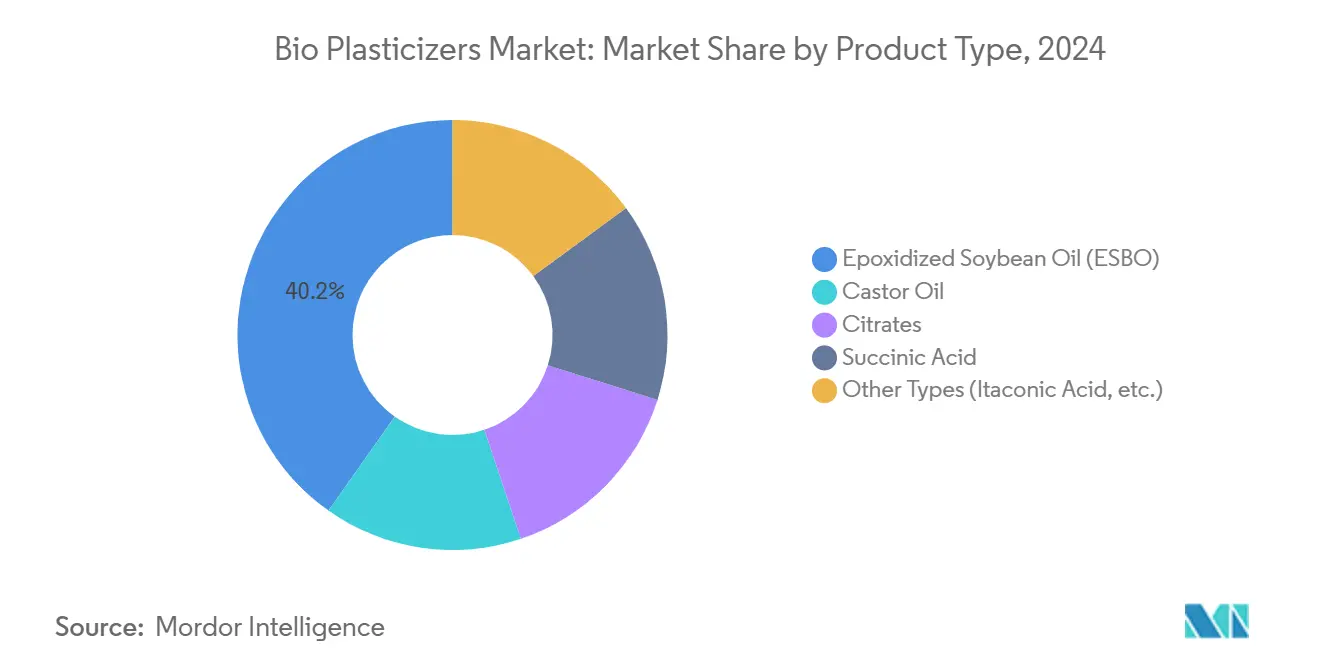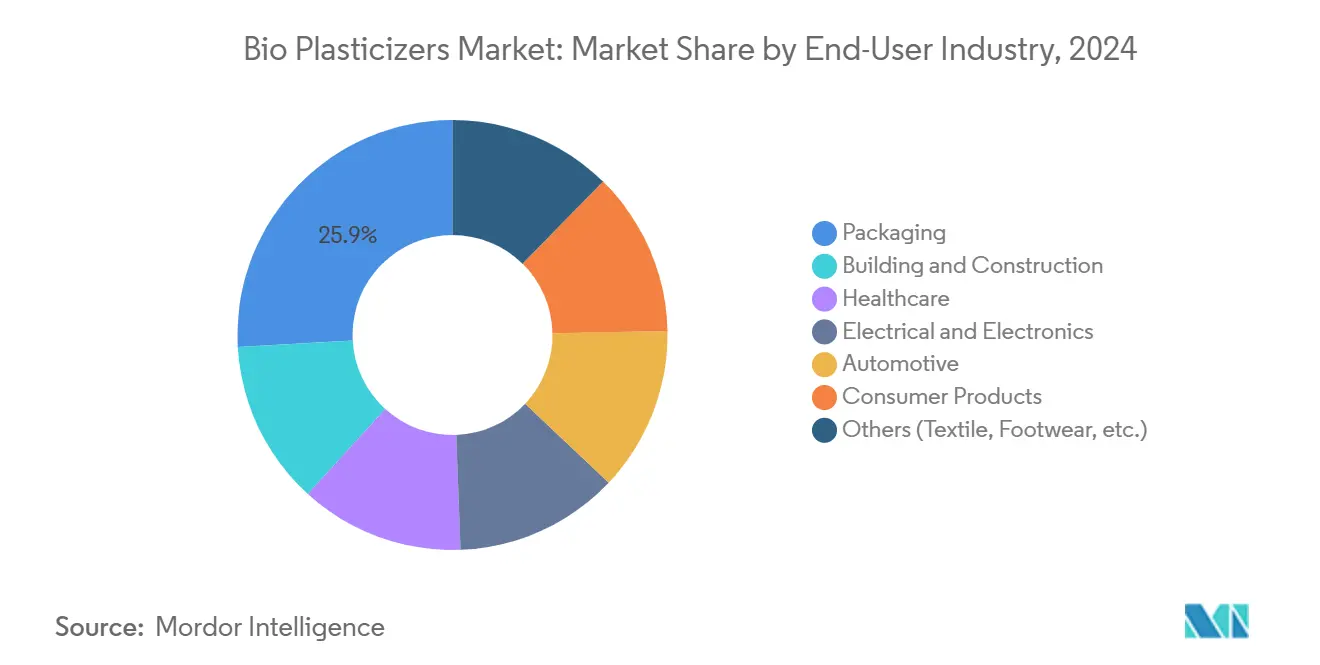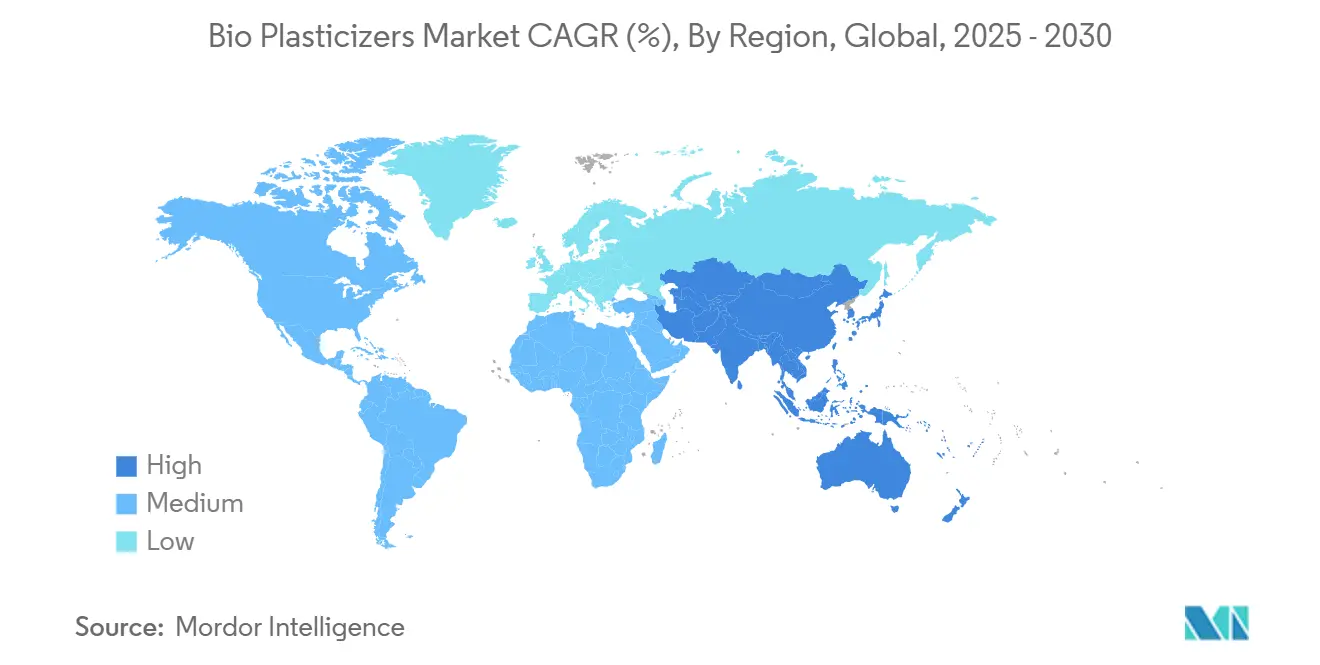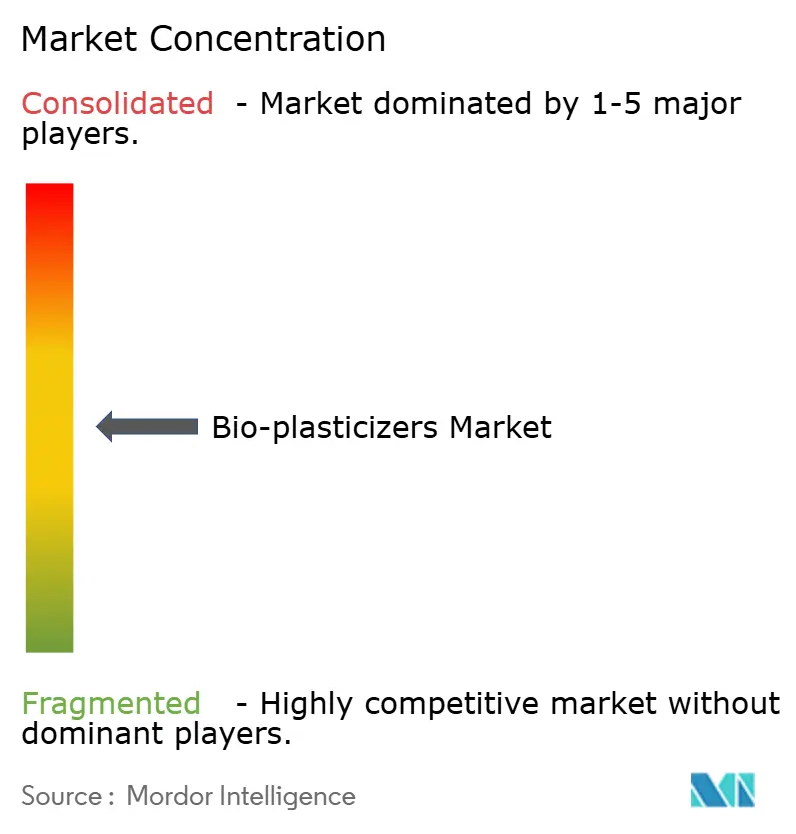Bio-plasticizers Market Size and Share

Bio-plasticizers Market Analysis by Mordor Intelligence
The bio plasticizers market stands at 474.27 kilotons in 2025 and is forecast to reach 642.81 kilotons by 2030, advancing at a 6.27% CAGR. Regulatory bans on phthalates, rising demand for renewable additives, and the rapid electrification of infrastructure collectively underpin this growth trajectory. Capacity expansions across Asia-Pacific bio-refineries are aligning with the automotive sector’s switch to bio-based materials for wire and cable insulation, reinforcing long-term volume increases. Supply-side momentum is further supported by strategic feedstock security programs in Thailand and India, while downstream demand in sustainable packaging accelerates adoption in films, sheets, and consumer goods. Intensifying competition among established chemical majors and specialized producers keeps pricing disciplined even as raw material costs fluctuate.
Key Report Takeaways
- By product type, Epoxidized Soybean Oil (ESBO) led with 40.21% of bio plasticizers market share in 2024; the “Other Types” segment is projected to expand at an 8.02% CAGR through 2030.
- By raw material source, plant oils accounted for 50.19% share of the bio plasticizers market size in 2024, whereas other raw material sources are forecast to grow at 7.51% CAGR between 2025-2030.
- By application, wire and cable captured 30.86% share of the bio plasticizers market size in 2024, while the “Other Applications” category is set to advance at 7.04% CAGR to 2030.
- By end-user industry, packaging commanded 25.89% of the bio plasticizers market size in 2024; automotive is the fastest-growing end-user with a 7.18% CAGR expected through 2030.
- By geography, Asia-Pacific held 35.18% of bio plasticizers market share in 2024 and is poised to grow at 7.67% CAGR, maintaining its dual leadership position.
Global Bio-plasticizers Market Trends and Insights
Drivers Impact Analysis
| Driver | (~) % Impact on CAGR Forecast | Geographic Relevance | Impact Timeline |
|---|---|---|---|
| Surging Flexible-PVC Demand from Wire and Cable Insulation | +1.80% | Global, with APAC leading | Medium term (2-4 years) |
| Stringent Phthalate Regulations to Boost the Use of Bio-Plasticizers | +2.10% | North America & EU primarily | Short term (≤ 2 years) |
| Rapid Capacity Additions of Bio-Refineries in Asia-Pacific | +1.20% | APAC core, spill-over to MEA | Long term (≥ 4 years) |
| Growth in the Sustainable Packaging Industry | +1.40% | Global | Medium term (2-4 years) |
| Availability of Renewable Feedstocks | +0.90% | Global, concentrated in agricultural regions | Long term (≥ 4 years) |
| Source: Mordor Intelligence | |||
Surging flexible-PVC demand from wire & cable insulation
Wire and cable insulation captured 30.86% of 2024 volume, and the segment’s technical specifications increasingly favor bio-derived additives that align with electrification standards. Manufacturers are replacing legacy phthalate systems with epoxidized and citrate esters that maintain dielectric strength in high-voltage environments. Trials confirm that polylactic acid blends can meet electrical property benchmarks, although polyhydroxybutyrate still requires mechanical enhancements for widespread adoption. Electric-vehicle producers are integrating these materials into interior wiring harnesses to satisfy corporate sustainability targets. The broader grid-modernization agenda further lifts demand, positioning flexible-PVC applications as an anchor segment for the bio plasticizers market.
Stringent phthalate regulations to boost the use of bio-plasticizers
The 2024 FDA decision eliminating 25 ortho-phthalates from food-additive regulations, together with California’s phased DEHP ban for medical devices, accelerates industry migration toward safer chemistries[1]U.S. Food and Drug Administration, “FDA Announces Final Rule Removing Ortho-Phthalates from Food-Additive Regulations,” fda.gov . Europe’s Regulation (EU) 2025/351 introduces tighter purity and migration thresholds effective March 2025, forcing converters to reformulate packaging and medical components[2]European Commission, “Regulation (EU) 2025/351 on Plastic Food Contact Materials,” europa.eu . Citrate esters and epoxidized vegetable oils gain rapid acceptance because they meet toxicological and performance requirements without extensive re-qualification. LANXESS, for instance, reports rising orders for Mesamoll as customers transition away from phthalate-rich formulations. This policy environment creates immediate pull for bio-based alternatives across food contact, healthcare, and children’s product lines.
Rapid capacity additions of bio-refineries in Asia-Pacific
Thailand’s approval of a 200,000 t/yr bio-ethylene plant marks a regional pivot toward domestically sourced bio-intermediates produced from sugarcane and cassava. The USD 1.54 billion investment reduces reliance on imported petroleum derivatives and sets a precedent for neighboring economies. India’s dominant castor-oil crop secures a critical feedstock base, though the country’s limited value-added processing capacity highlights opportunities for new vertically integrated investments. Local governments incentivize bio-chemicals through tax relief and preferential power tariffs, strengthening the medium-term supply outlook. These initiatives collectively reinforce Asia-Pacific’s status as both the largest and fastest-growing regional hub.
Growth in the sustainable packaging industry
Brand owners in beverage, personal-care, and ready-meal segments continue to launch plant-based containers that require compliant plasticizers able to preserve flexibility and seal integrity. Recent pilot-scale production of recyclable PLA films incorporating non-toxic polyether plasticizers showcases the technical feasibility of fully bio-derived packaging solutions. The Sustainable Packaging Coalition in North America and parallel European programs provide industry-led testing frameworks that de-risk adoption. Consumer preference surveys reveal sustained willingness to pay premiums for compostable packs, reinforcing volume uptake. As a result, packaging remains the single largest end-use, though its growth pace now parallels the rapid expansion in automotive interiors.
Restraints Impact Analysis
| Restraint | (~) % Impact on CAGR Forecast | Geographic Relevance | Impact Timeline |
|---|---|---|---|
| Price Volatility of Vegetable Oils | -1.60% | Global, particularly agricultural regions | Short term (≤ 2 years) |
| Performance Gap in High-Temperature Applications | -0.80% | Global, concentrated in automotive & industrial | Medium term (2-4 years) |
| Availability of Alternatives | -0.70% | Global, with stronger impact in developed markets | Medium term (2-4 years) |
| Source: Mordor Intelligence | |||
Price volatility of vegetable oils
Castor- and soybean-oil prices remain sensitive to weather patterns, export policies, and competing biofuel demand, creating procurement uncertainty for plasticizer producers. Weak demand in early 2025 led to bearish pricing, yet historical swings underscore ongoing exposure. Companies increasingly pursue multi-feedstock sourcing strategies and invest in agronomic improvements to stabilize yields. Policymakers in the United States and European Union offer agricultural subsidies and tax credits that partially offset cost spikes, though broader commodity cycles still influence margins. Forward-contracting and derivative hedging gain popularity among large buyers seeking price transparency and supply assurance.
Performance gap in high-temperature applications
Polylactic acid’s heat-deflection ceiling of 55-65 °C limits its use in automotive engine bays and industrial electronics. Additive packages incorporating nucleating agents raise thresholds to near 100 °C, but sustained exposure remains challenging compared with conventional plasticizers. DuPont’s polymer modifiers extend PLA’s thermal resistance to 95 °C, indicating progress yet highlighting the remaining gap. High-temperature electrical parts, braking systems, and under-hood components thus continue to rely on traditional plasticizers or specialty petrochemicals. Ongoing research into stereocomplex PLA structures and reactive extrusion techniques seeks to close the performance gap without undermining biodegradability.
Segment Analysis
By Product Type: ESBO dominance faces innovation challenge
ESBO captured 40.21% of 2024 volume on the strength of mature production networks and regulatory approvals for food contact. That leadership delivers favorable unit economics and assured supply to converters. Nevertheless, the “Other Types” segment—covering itaconic acid derivatives and novel bio-esters—will post the highest 8.02% CAGR, reflecting the industry’s appetite for chemistries offering enhanced temperature resistance and lower migration. Modifications that raise the oxygen content of ESBO improve plasticization efficiency, indicating that incumbent products continue to evolve to defend share. Meanwhile, castor-oil derivatives gain traction for specialty gaskets and seals that demand superior hydrolytic stability. Close control over feedstock purity remains the critical determinant of consistent performance across all product types.
In volume terms, ESBO will still dominate the bio plasticizers market in 2030, yet its share is expected to taper as new chemistries reach commercial scale. Converters value supply-chain resilience, leading many to dual-source between ESBO and emerging esters to mitigate risk. Patent activity confirms sustained R&D investments across both legacy and next-generation categories, underscoring a dynamic competitive environment that balances cost containment with functional differentiation.

Note: Segment Share of all individual segments available upon report purchase
By Raw Material Source: Plant oils lead diversification drive
Plant oils contributed 50.19% of 2024 inputs, anchoring the bio plasticizers market size at the raw-material level. Soybean and castor oils remain workhorses owing to established agronomic supply chains and global trade liquidity. Nevertheless, other raw material types are set to grow 7.51% annually, powered by lignin-based compounds and agricultural residue streams that improve circularity. Organic acids and anhydrides support niche applications where specific chemical moieties deliver targeted performance characteristics. Glycerol esters, valued for cost-competitiveness, fill general-purpose demand where extreme mechanical strength is not mandatory.
Arkema’s successful scale-up of Rilsan PA11 from castor oil illustrates the commercial viability of differentiated feedstocks, while Pebax Rnew highlights opportunities for plasticizer-free elastomers that meet the same end-use objectives[3]Arkema, “Rilsan PA11: High-Performance Polymer from Renewable Castor Oil,” arkema.com . These examples demonstrate how feedstock diversification is both a risk-mitigation strategy and a pathway to higher-margin offerings. As capital flows into new processing technologies, lignin and agricultural wastes are likely to command a growing slice of the bio plasticizers market.
By Application: Wire & cable strength meets automotive innovation
Wire and cable kept its pole position with 30.86% share in 2024, cementing the segment as the volume bedrock of the bio plasticizers market. High-voltage requirements drive adoption of epoxidized and citrate systems that satisfy dielectric and flame-retardancy standards without sacrificing flexibility. Shipments into this segment are expected to rise steadily in parallel with grid upgrades and electric-vehicle charging infrastructure worldwide. Conversely, “Other Applications,” which comprise automotive interiors and specialized engineering parts, will achieve the highest 7.04% CAGR. OEMs specify bio-based additives for dashboards, door panels, and trim to advance mandated sustainability targets while keeping weight in check.
Film and sheet uses benefit from rising consumption of biodegradable packaging, and flooring and roofing applications draw strength from green-building mandates. Medical devices, particularly tubing and IV bags, transition toward bio-derived plasticizers following phthalate bans, reinforcing niche but high-value demand. Electrical properties demonstrated by PLA blends validate their extension into cable management systems, bridging the historical divide between packaging and industrial markets.
By End-User Industry: Packaging leadership challenged by automotive growth
Packaging absorbed 25.89% of bio plasticizers in 2024, mirroring regulatory crackdowns on phthalates in direct-food contact. Demand spans flexible films, rigid containers, and cap liners that require additives enhancing sealability and puncture resistance. Building and construction provides stable volumes for flooring materials, whereas healthcare imposes exacting biocompatibility standards that favor fully bio-derived chemistries. Automotive, however, posts the swiftest 7.18% CAGR, spurred by electric-vehicle platforms that prioritize lightweight and low-VOC interiors. Dow’s launch of bio-based NORDEL REN EPDM underlines the sector’s strategic pivot toward renewable elastomers.
Electronics manufacturers also turn to bio-plasticized resins for casings and cable assemblies, aligning corporate carbon goals with material compliance. Consumer products such as toys and stationery integrate bio-plasticizers to meet evolving retailer sustainability policies. The shifting end-user mix signals that while packaging retains the largest absolute demand, higher-margin industrial uses are set to capture an increasing proportion of market value.

Note: Segment Share of all individual segments available upon report purchase
Geography Analysis
Asia-Pacific owned 35.18% bio plasticizers market share in 2024 and is forecast to expand at 7.67% CAGR through 2030, an uncommon blend of scale and growth velocity. Thailand’s bio-ethylene project exemplifies the region’s transition toward localized bio-feedstock conversion, reducing exposure to petroleum imports and supporting domestic downstream industries. India’s extensive castor-oil cultivation underpins regional supply security, though constraints in value-added processing present investment openings for integrated players. The Chinese government’s forthcoming oversight framework for recycled plastics in food contact will reinforce demand for compliant bio-plasticizers throughout consumer-goods supply chains.
North America continues to wield regulatory influence and technological leadership. Dow’s agreement to source corn-stover-derived ethylene inaugurates agricultural-waste valorization at scale, reinforcing the continent’s commitment to circular chemistry. Federal incentives under the Inflation Reduction Act enhance the economics of bio-based intermediates, compensating for higher capital requirements compared with fossil alternatives. Mature logistics and abundant feedstocks further entrench competitive positioning.
Europe maintains a stringent compliance regime, with new purity and migration limits prompting converters to accelerate reformulation. The market rewards suppliers able to prove cradle-to-gate carbon reductions while upholding mechanical performance. Regional recyclates must satisfy traceability rules, adding complexity but also encouraging the uptake of certified bio-balance pathways. South America and the Middle East & Africa represent nascent demand centers where consumer awareness and infrastructure investments are still emerging. Nonetheless, abundant biomass resources position these regions for future capacity expansions once regulatory frameworks mature.

Competitive Landscape
Competition is moderately fragmented, blending multinational chemical firms with agile specialists. BASF, Dow, and Cargill leverage global feedstock contracts and multi-purpose production assets to maintain cost leadership. Their broad portfolios cover ESBO, citrate esters, and biomass-balanced grades that customers can qualify across diverse end-uses. Mid-tier innovators focus on single-chemistry expertise, targeting applications where performance gaps remain. Perstorp’s Pevalen Pro 100 and Evonik’s biomass-balanced ammonia illustrate differentiated approaches that emphasize reduced carbon footprints and heightened purity.
Strategic alliances shape market structure. Evonik and BASF’s partnership on low-carbon ammonia secures intermediate inputs while lowering product carbon footprints by over 65%. Dow’s corn-stover sourcing pact underscores the push toward vertically integrated waste-based supply chains. Patent filings for lignin-based esters and itaconic-acid derivatives indicate a pipeline of disruptive options that could reset performance benchmarks. Market participants also invest in digital traceability solutions, enabling end-users to verify sustainability claims in real time.
Bio-plasticizers Industry Leaders
-
BASF SE
-
Cargill, Incorporated.
-
Dow
-
Evonik Industries AG
-
LANXESS
- *Disclaimer: Major Players sorted in no particular order

Recent Industry Developments
- February 2025: BASF expanded its sustainable North American plasticizer range with ISCC PLUS certified biomass-balanced and Ccycled grades, including Palatinol DOTP Advantage 50 and Palatinol DOTP Ccycled, providing performance equivalence to conventional products while lowering carbon intensity.
- March 2024: Baerlocher has initiated the distribution of Innoleics' portfolio of non-phthalate bio-plasticizers in the United States. This development is anticipated to strengthen the bio-plasticizers market by driving demand for sustainable and non-phthalate alternatives.
Research Methodology Framework and Report Scope
Market Definitions and Key Coverage
Our study defines the bio-plasticizers market as all renewable-origin additives, such as epoxidized soybean oil, castor-oil products, citrates, and succinic-acid derivatives, blended into polymers to improve flexibility, predominantly in PVC compounds used across packaging, wire & cable, flooring, and automotive interior parts.
Scope Exclusion: Petroleum-derived and other non-renewable plasticizers are outside this assessment.
Segmentation Overview
- By Product Type
- Epoxidized Soybean Oil (ESBO)
- Castor oil
- Citrates
- Succinic acid
- Other Types (Itaconic acid, etc.)
- By Raw-Material Source
- Plant Oils
- Organic Acids and Anhydrides
- Glycerol Esters
- Others (Lignin-based Compounds, etc.)
- By Application
- Wire and Cable
- Film and Sheet
- Flooring, Roofing and Wall-covering
- Medical Devices
- Consumer Goods
- Other Applications (Automotive Interior Parts, etc.)
- By End-User Industry
- Packaging
- Building and Construction
- Healthcare
- Electrical and Electronics
- Automotive
- Consumer Products
- Others (Textile, Footwear, etc.)
- By Geography
- Asia-Pacific
- China
- India
- Japan
- South Korea
- Rest of Asia-Pacific
- North America
- United States
- Canada
- Mexico
- Europe
- Germany
- United Kingdom
- France
- Italy
- Rest of Europe
- South America
- Brazil
- Argentina
- Rest of South America
- Middle East and Africa
- Saudi Arabia
- South Africa
- Rest of Middle East and Africa
- Asia-Pacific
Detailed Research Methodology and Data Validation
Primary Research
Mordor analysts interviewed compounders, additive formulators, and PVC processors across North America, Europe, and Asia Pacific. Discussions verified substitution rates versus phthalate products, average dosage levels, and emerging end-use tests (for example, biodegradable cling films). Follow-up surveys with procurement managers provided price-band checkpoints and outlook sentiment that sharpened model assumptions.
Desk Research
We began with public domain datasets issued by agencies such as the United States Environmental Protection Agency, Eurostat's Prodcom series, and China's National Bureau of Statistics, which together clarify regulatory triggers and production volumes. Trade flows from UN Comtrade and customs dashboards expose import-export balances for key feedstocks, such as soybean oil and citrate esters. Industry associations, including the European Plastics Converters and the Vinyl Institute, provide application-level penetration hints, while company filings and investor decks supply average selling prices. Where finer detail is required, analysts tap licensed resources like D&B Hoovers for manufacturer revenues and Dow Jones Factiva for transaction news. The sources cited here are illustrative; many additional references underpin our dataset assembly.
Market-Sizing & Forecasting
A blended top-down build begins with polymer production and trade statistics, which are then adjusted by region-specific bio-plasticizer penetration rates, average loading percentages, and recovery factors to arrive at demand in kilotons. Supplier roll-ups and sampled price × volume checks offer a bottom-up sense-check before totals are finalized. Key variables tracked include national PVC output, phthalate substitution mandates, soybean-oil price spreads, building & construction activity indices, and medical-device tubing demand shifts. Five-year forecasts leverage multivariate regression, anchoring future volumes to GDP, construction spending, and price elasticities surfaced in primary work. Scenario analysis stresses the model for rapid regulatory tightenings. Data gaps in small geographies are bridged via proxy ratios drawn from adjacent markets with similar consumption patterns.
Data Validation & Update Cycle
Outputs pass a three-layer review: peer analyst audit, senior consultant sign-off, and automated variance checks against external trade and producer filings. We refresh every twelve months; interim updates trigger when feedstock price shocks, new regional bans, or capacity additions alter underlying assumptions. A final pre-publication sweep assures clients receive the latest calibrated view.
Why Our Bio Plasticizers Baseline Commands Reliability
Published estimates often diverge because firms report in different units, fold in broader eco-friendly additives, or assume uniform adoption speeds.
Key gap drivers include varied inclusion of non-PVC applications, inconsistent average selling price ladders, and refresh cadences that overlook recent capacity ramps in Asia. Mordor's discipline, linking bio-plasticizer demand directly to verified polymer output and substitution ratios, produces a defensible midpoint rather than an aggressive or conservative extreme.
Benchmark comparison
| Market Size | Anonymized source | Primary gap driver |
|---|---|---|
| 474.27 kilotons | Mordor Intelligence | - |
| USD 1.49 billion (2024) | Global Consultancy A | Uses headline revenue, mixes bio-based with broader eco-friendly plasticizers, limited regional split |
| USD 3.22 billion (2024) | Industry Association B | Assumes universal price premium, omits small-scale Asia manufacturers, older 2023 base |
| USD 1.68 billion (2024) | Trade Journal C | Applies flat 6% growth to historic demand, no primary validation of substitution rates |
In sum, the Mordor approach anchors demand to measurable production drivers, validates critical ratios with on-ground experts, and revisits the numbers on a predictable cycle, giving decision-makers a transparent, balanced baseline they can trace and replicate.
Key Questions Answered in the Report
What is the current size of the bio plasticizers market?
The bio plasticizers market totals 474.27 kilotons in 2025 and is projected to reach 642.81 kilotons by 2030.
Which region leads the bio plasticizers market?
Asia-Pacific holds the largest regional position with 35.18% share in 2024 and records the fastest 7.67% CAGR outlook.
Which product type dominates the bio plasticizers market?
Epoxidized Soybean Oil (ESBO) remains the top product, accounting for 40.21% of 2024 volumes.
Why are bio plasticizers gaining popularity in packaging?
Regulatory bans on phthalates and consumer demand for compostable packaging drive converters to adopt bio-plasticized films and containers that meet safety and sustainability requirements.
What growth rate is anticipated for automotive applications?
The automotive segment is forecast to expand at 7.18% CAGR through 2030 as electric-vehicle makers integrate bio-based additives into interior components and wiring.
How volatile are feedstock prices for bio plasticizers?
Vegetable-oil inputs experience price swings linked to weather and policy factors, exerting short-term cost pressure and prompting manufacturers to diversify feedstock sourcing.
Page last updated on:



